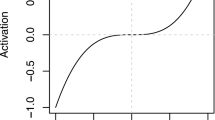Conclusions
We have given evidence by mathematical analysis and by example that the construction of CAM's as quasineural networks based on the twin principles of an outer-product weight matrix and a random asynchronous single-neuron dynamics encounters two obstacles to good performance which appear to be inherent. It is desirable to have the stored memory vectors of a CAM as mutually far apart as possible in order to have unambiguous retrieval with as large a fraction of initial errors (minrad) as possible. For a given number,m, of memory vectors to be stored this requires that their dimension,n, be larger thanm and that the memory vectors be nearly mutually orthogonal (except for complementary pairs). In HOCAM's, it does not seem possible to have both a large minrad and an efficient ratiom/n. Attempts to increasem/n are likely to introduce extraneous fixed-points which reduce minrad appreciably. We have demonstrated this phenomenon in several cases for a particular mode of constructing CAM's of arbitrary size which have a desirable spacing between memory vectors. We conjecture that it is present also in HOCAM's having a random selection of memory vectors. (A mathematical proof of this conjecture now seems possible.) This may account for the rather pessimistic results on capacity obtained by mathematical analysis here and in Cottrell (1988), by a probabilistic analysis in Posner (1987) and by simulation in Hopfield (1982). Further, in Cottrell (1988) there is evidence that outer-product weights are near optimal with respect to minrad, so that otherW may not improve matters.
We have left to another paper a study of other approaches to content-addressable memories of which we are aware, but which are not focused on asynchronous dynamics; e.g. computer CAM's as in Kohonen (1977) and biological memory models as in Little (1974); Palm (1980) and Little and Shaw (1978). We have not considered the learning, or adaptive, aspects of CAM's. However, insofar as learning is Hebbian and leads to outer-product weights, our analysis has implications for the effectiveness of learned weights, as may be inferred from our results on ambiguous retrieval.
Similar content being viewed by others
References
Cottrell M (1988) Stability and attractivity in associative memory networks. Biol Cybern 58:129–139
Hopfield JJ (1982) Neural networks and physical systems with emergent collective computational abilities. Proc Natl Acad Sci USA, vol 79, Biophys 2554–2558
Kohonen T (1987) Content-addressable memories, 2nd ed; Associative memory, a system-theoretic approach. Springer, Berlin Heidelberg New York
Kosko B (1987) Adaptive bidirectional memories. Appl Opt 26:4947–4960
Little WA (1974) The existence of persistent states in the brain. Math Biosci 19:101–120
Little WA, Shaw GL (1978) Analytic study of the memory storage capacity of a neural network. Math Biosci 39:281–290
McCulloch WS, Pitts W (1942) A logical calculus of the ideas immanent in nervous activity. Bull Math Biophys 5:115–133
Palm G (1980) On associative memory. Biol Cybern 36:19–31
Peterson WW (1961) Error-correcting codes. Wiley, New York
Posner E, McEliece R, Rodemich ER, Venkatesh S (1987) The capacity of the Hopfield associative memory. IEEE Trans IT-33:461–482
Wang Xin (1989) On 2n-CAM's in ann-cube. U. S. C. Report
Weisbuch G, Fogelman-Soulie F (1985) Scaling laws for the attractors of Hopfield networks. J Phys Lett 46:L623-L630
Author information
Authors and Affiliations
Additional information
This research was partially supported by NSF Grant CCR-87121192 and AFOSR Grant 88-0245
Rights and permissions
About this article
Cite this article
Blum, E.K. Mathematical aspects of outer-product asynchronous content-addressable memories. Biol. Cybern. 62, 337–348 (1990). https://doi.org/10.1007/BF00201448
Received:
Accepted:
Issue Date:
DOI: https://doi.org/10.1007/BF00201448




